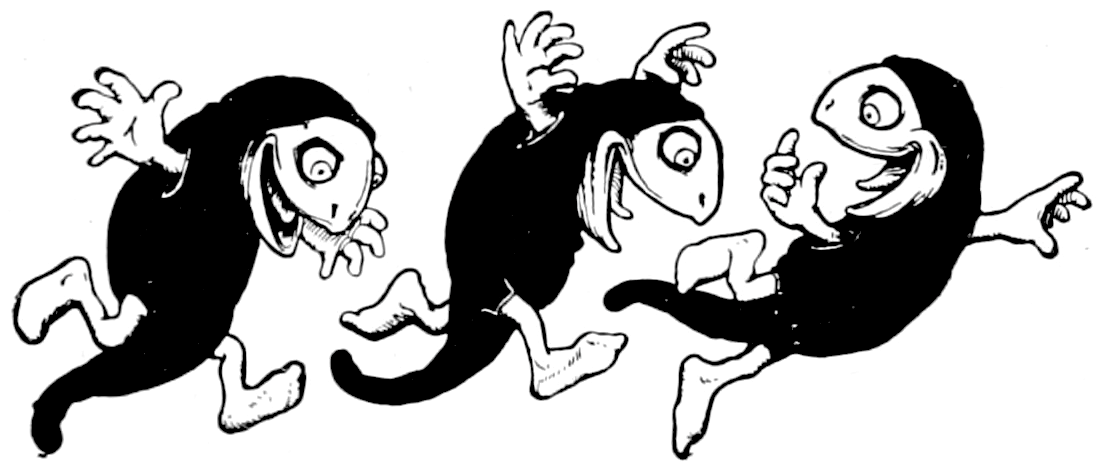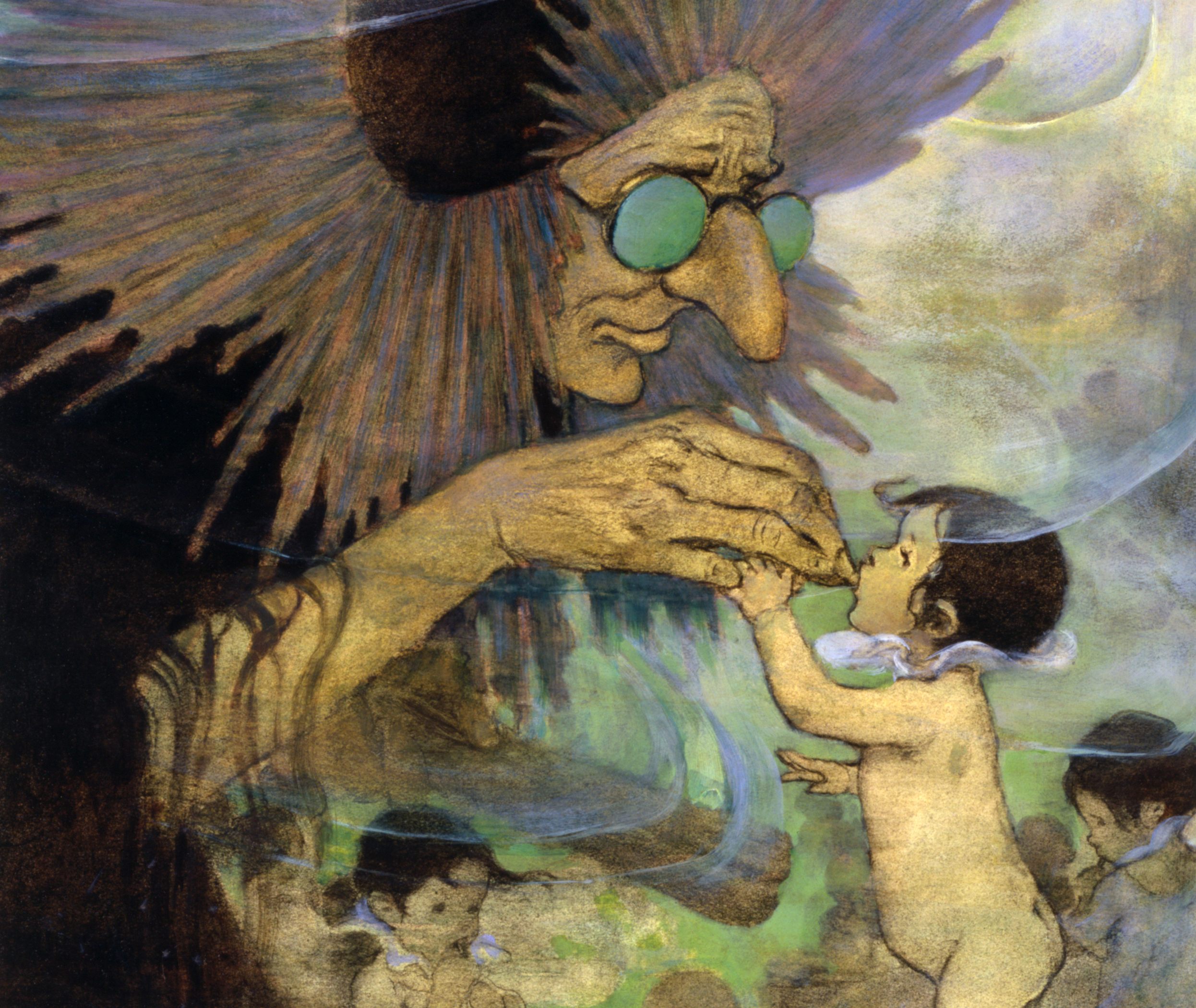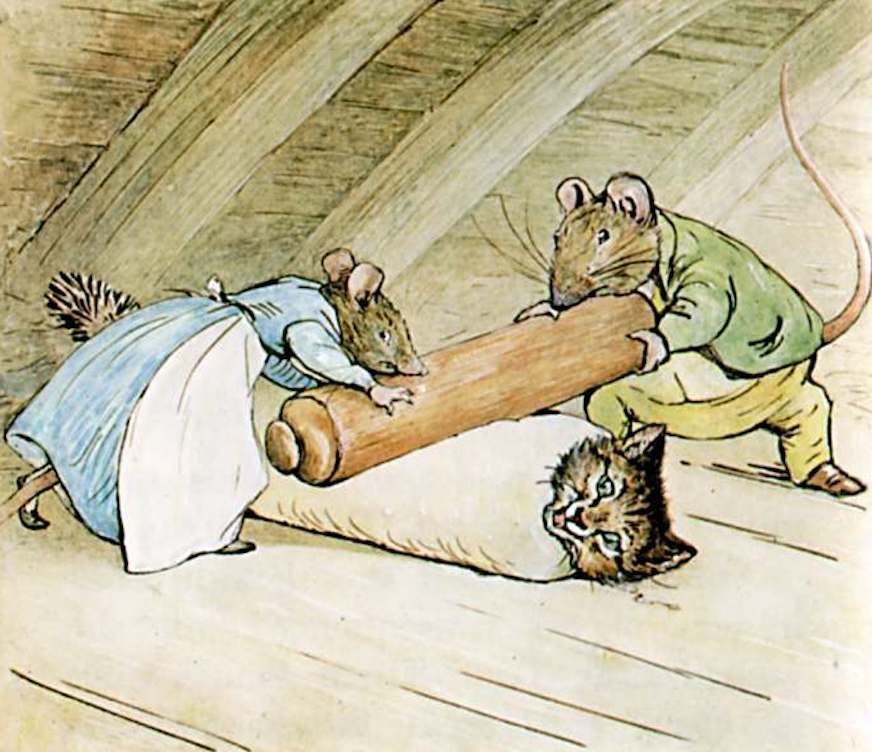24 Children’s Stories That Still Give Us the Creeps
Atlas Obscura readers wrote in about the classic tales that taught them one thing—unease.

The stories and books we consume as children can stick with us our entire lives. Sometimes it’s because they successfully impart important lessons, but often times it’s because they scared the wits out of our childhood selves. Recently we asked Atlas Obscura readers to tell us about the kids’ books and stories that still creep them out. The responses gave us chills.
You told us about classic fairy tales that left you feeling uneasy. There were folktales, too, such as the monster-under-the-bed known as “Soap Sally,” who turns kids’ fingers into soap. And many of you wrote to us about specific books that gave you nightmares, such as the eerie favorite The Water-Babies. All kid-friendly, all horrifying.
Take a look through some of our favorite submissions below, and try not to freak yourself out. If you have a children’s story from your part of the world that still give you the creeps, head over to our new Community forums and tell us about it!

“The Girl Who Trod on the Loaf”
“Hans Christian Andersen had a thing for writing stories about naughty girls and the punishments meted out to them. This one concerns a poor girl who was raised up to live in better surroundings and became very conceited. When sent to visit her poverty-stricken mother, she dropped the loaf of bread that she’d been given for her family into the mud so she could step on it instead of getting her shoes dirty. But she sticks to the loaf and sinks down below the mud, is taken into Hell, stiffens into a statue, and goes through all sorts of horrific torments (flies, slime, bugs crawling across her eyes, hunger) while listening to her mother’s tears and people saying what a horrible person she was. At last she escapes her own disintegrating body in the shape of a bird, and spends a winter collecting and giving away to other birds enough crumbs to equal the weight of the loaf. And at last, she flies away (presumably to Heaven.)
I couldn’t get past the idea of being stuck inside your own body, utterly helpless. It’s an incredibly hopeless situation and she KNOWS it’s all her fault, and there’s such a slim chance that she can ever make things better. I guess it says something about me and my fear of being helpless. It’s pretty strong.” — Suzanne Barnes, Tucson, Arizona
“The Tailypo”
“A hungry farmer and his three dogs eat the tail of a strange creature (it’s black with yellow eyes). The creature returns, demanding the return of its ‘tailypo.’ It kills the three dogs over the course of three nights and ends its reign of terror by killing the farmer.
This was read to my 1st or 2nd grade class in the library and haunted me for years to come. Having looked into it as an adult, I have learned that it’s Southern folklore. Some versions include evisceration of the farmer so the thing can get its tail back. Why would anyone read this to children?!” — Rebecca, Massachusetts
“Soap Sally”
“Soap sally lives under the bed and would turn your thumb into soap if you didn’t go to sleep. My mom told me that she turned my aunt’s thumb into soap.” — Dorothy E., U.S.A.

“The Hobyahs”
“Brave little dog Turpie kept barking in the night because the Hobyahs came creeping around the forest hut of his owners, an elderly couple. The old man daily threatens the dog with dismemberment for barking. Every day, he cuts off another limb or tail and still the dog barks. Ultimately, his head is removed and the dog ceases barking.
The illustrations of dismembered dog body parts casually placed inside the hut on a shelf [scared me]. No blood! And all because the dog is trying to defend his owners. This story was in a primary school reader! Gave me nightmares.” — Jessie Shaw, Virginia
“Mr. Pop Corn”
“When I was young, my mother purchased several antique children’s books from the late 1800s to the early 1900s. One of the books had very short stories, like poems, no longer than two-to-three pages. Mr. Pop Corn was illustrated as a dapper ear of corn with a top hat, like the famous Mr. Peanut. The neighborhood children snuck up and assaulted Mr. Pop Corn, and sheared off his kernels, then put the kernels in a big pot, and made popcorn. The children ate happily and had their fill. Poor Mr. Pop Corn. This was illustrated. Children giving chase, Mr. Pop Corn running, kernels popping, all around the text. As a child, I was horrified. Ripping the kernels off and popping them and eating them, that is a horror story.” — Linda, New Mexico
“The Little Sister Carries Her Doll”
“It is a ballad:
‘The little sister carries the doll on her back
walking in the garden to see the blossom flower
the doll is crying out, “Mama (Mom)”
the bird on the tree is giggling.’
Although I depend on the functions of psychology and linguistic anthropomorphism to explain why the doll cries out ‘Mama’ and the bird giggles, I still feel scared of this ballad for children.” — Bin, Taiwan

The Water-Babies
By Charles Kingsley
“It’s about a little chimney sweep who was chased out of town, and he finds himself living underwater with a group of other children. I’m pretty sure all of the children in the story are dead, including the little boy.” — Courtney Downs, Denver, Colorado
The Tooth Fairy
By Anita Feagles
“The Tooth Fairy is this cute little twiggy waif girl who works harder than the Easter Bunny and Santa Claus because she has to work all year round. She loves teeth and has bucket loads of them that she sorts into boxes of girl’s teeth, boy’s teeth, top teeth, bottom teeth, EXTRAS, etc. She uses teeth to decorate her fish bowl, in a jar on the kitchen shelf, the path to her house is paved with teeth, she has garlands of teeth outside the house. She has a party for all the fairies once a year and they all get gifts of teeth. And play games with teeth. And the reason she loves teeth so much is because she doesn’t have any of her own!
Although it’s meant to be a sweet, goofy story describing The Tooth Fairy, I found it creepy as a kid because she doesn’t have teeth in her mouth, and feels the need to hoard them, using them as decorations and giving them as gifts. Making jewelry out of teeth. Paving her walkway with teeth! It’s just not right.” — Amanda Walz, Detroit, Michigan
Bony-Legs
By Joanna Cole
“It’s a Baba Yaga story (house on chicken feet, razor sharp teeth, eating small children). She captures a girl and makes her get herself ready to be cooked/eaten. The girl is helped by various maltreated pets and gates. The pictures of Bony-Legs are… haunting. For some reason this was my favorite book when I was in kindergarten and I read it just about every day. Then out of nowhere, I became afraid of the pictures and hid them behind the other books so she didn’t stare at me while I slept. Then for a stretch I became convinced that Bony-Legs lived underneath my bed with the villain from Superman II as her lackey.” — Marissa Miller, Minnesota

Max and Moritz
By Wilhelm Busch
“Max and Moritz are two naughty little boys that like to play pranks on their neighbors. They play mean-spirited pranks, like causing local chickens to eat strings and die entangled together; removing planks from a bridge; almost killing a tailor; adding gunpowder to their teacher’s pipe, and nearly blowing him away; that sort of thing. Eventually they slit open sacks of the farmers corn. They end up stuffed into the sacks, brought to the mill, and ground to pieces. They end up being fed to the local ducks. They are not missed. (In fact, the farmer sort of relishes in grinding them up…) The farmer knowingly (and happily!) feeds ground up children to the birds. And the whole town is okay with it. Also, once they’ve been ground, the illustration shows the ducks eating grain shaped like little boys.” — Sarah H., Florida (family is from Germany)
The Duchess Bakes a Cake
By Virginia Kahl
“The titular Duchess decides to take a break from duchessing and bake a cake. Things go horribly awry when the batter starts rising like bread dough, and simply doesn’t stop. The Duchess climbs onto the concoction to try to stop it from rising higher. Instead, it rises with her on it, trapping her very high up on a tower made of cake. Her husband and children see what’s happened and fear she’s trapped forever. However, the Duchess comes up with a plan: everyone will eat the cake so that she can safely get down.
One line that has always stuck with me and upset me, even when I was very little, comes up when the Duke and the children see the Duchess stuck out of reach. The youngest child begins to cry and the Duke responds, ‘Don’t cry, dear, about your poor mother. I’m sure, if you wish, I can find you another.’ The absolute callousness and willingness to replace his wife horrified me. It still does (even as an adult who knows that political marriages have existed for a very long time).” — Rose, New Jersey
Ozma of Oz
L. Frank Baum
“A sequel to Wizard of Oz, wherein Dorothy restores the rightful ruler to the throne of Ev with help from a variety of the odd characters Oz is famous for. [It is creepy for] so, so many reasons. Princess Langwidere and her collection of heads for every moment; The Nome King and the horror of being turned into decorative tchotchkes, unable to tell your friends who you are; and the Wheelers. The early 1900s moral code is very evident, and is fascinating to compare as an adult and parent nowadays.” — Moria Bergeron, Sunnyvale, California

The Tale of Samuel Whiskers
By Beatrix Potter
“It’s a Beatrix Potter tale in which a kitten, exploring the space between the walls of his house, finds himself rolled in dough and nearly consumed by rats. This idea that there are little creatures lurking just out of sight that would kill and eat you if but given the opportunity, is startling to a child who has never had anything other than positive interactions with animals. It reframes the image of the home as a safe bulwark against raw nature.” — Ginger, Pennsylvania*
“Little Orphant Annie”
By James Whitcomb Riley
“It’s a poem about an orphan girl who’s taken into a 19th-century household to do all the housework. But, after dinner, she tells the kids of the house horrible stories about what goblins do to you if you act up. ‘The goblins’ll get you if you don’t watch out!’ The first cautionary tale in the poem has a boy who, because he wouldn’t say his prayers, was snatched out of his bed in the night by goblins, and all his parents find left behind are his pajama bottoms. The idea of a boy taken away, naked from the waist down, almost made me sick.” — Julie Huffman, Los Angeles, California
“Rubber Bum”
“My English aunt always told us this story. A young lad was sent to market to buy bacon. Instead of buying it, he slices off a part of his buttocks and pockets the money. Mom says how delicious it is. This happens day after day until he runs out of buttocks. The aghast parents have him fitted with a rubber prosthesis. He falls down one day, bounces, and is never seen again. I’ve asked many people if they know the story, no one has. Now I understand why my aunt didn’t have children.” — Beverly Demko, Reynoldsburg, Ohio

“The Tinderbox”
“A soldier meets a witch who sends him down into a tree where he finds money guarded by dogs with giant eyes. He then goes broke and the dogs return to give him more money. He then gets the dogs to steal a princess and rip everyone else to shreds.
[Creepy things:] The witch who wants the mysterious tinderbox but not the fortune; the tree with underground rooms; the dogs with hideously large eyes (the illustrations still haunt me) that he has to gingerly pick up and move; the dark attic the broke soldier lived in; the striking of the match and the scary dogs appearing; the marking of the town’s doors to find out where the princess goes at night; and the end note of the beautiful wedding feast with the hideous dogs enjoying.” — SW, U.S.A.
The Bears’ Famous Invasion of Sicily
By Dino Buzzati
“Facing famine, the bears come down from the mountains of Sicily, defeat the Grand Duke of Sicily in a bloody battle, and then take over the monarchy and live like humans, until the king is killed by a sea monster. The illustrations, the giant cat, Marmoset, the sea monster, and the battle scenes, were both creepy and compelling. Also, the English translation is in this cheerful doggerel that takes you bumping along from one horror to the next.” — Chris Hawthorne, Los Angeles, California

“Hansel and Gretel”
“Honestly, there are quite a few kids stories, even Little Red Riding Hood, that trip me out now that I’m much older, but this one I find very disturbing. A story about two children who got lost in a forest and end up at a cottage made of candy, then have to fight a hostage situation, and end up defending themselves by killing someone. It’s a luring, kidnapping, and murder story involving CHILDREN. Kids getting lost is scary enough (can you tell I’m a parent?), but being taken hostage with the intent of being eaten (cannibalism), then for a child having to make such as decision as ‘it’s us or her’ — innocence lost!” — Faniso Zimunya, Victoria Falls, Zimbabwe
“The Three Little Men in the Wood”
“Typical Cinderella-type story about a beautiful step-daughter and a wicked stepmother who plans to kill her. At the end, the heroine marries a king and he sentences the wicked stepmother and her awful daughter to be put into a cask, stuck round with nails, and rolled down a hill into the water. Pretty awful punishment, not to mention gruesome. And I have never forgotten it.” — Lauri Taylor, Salt Lake City, Utah
“The Strange Feast”
“A sausage became friends with a blood sausage. The blood sausage invited him over, then left the room. The sausage saw strange things, like a broom and dustpan arguing, and a monkey babbling to itself. Something or other warned him to run. He ran outside, and back through the window, he saw the blood sausage. It was holding a sharp knife, and said, ‘If I hadn’t warned you, I’d have had you!’ What’s creepier than a children’s story about a serial killer? Somehow anthropomorphizing a blood sausage only makes it more disquieting.” — Perry Fergin, Baltimore, Maryland

“Rumpelstiltskin”
“A mischievous little goblin man offers to help a girl who’ll be either executed or imprisoned forever by a king if she isn’t able to use a spinning wheel to turn ordinary straw into gold. The catch? She has to give up her first born child unless she can guess the imp’s name within three days of him coming to collect the debt. When she has her first kid, Rumpelstiltskin returns, and the girl desperately tries to guess his name to no avail. But on the night before the third day, she sneaks into the woods to find him, and overhears him singing a song in which he reveals his name. The next day, she says his name and he loses his prize and they live happily ever after.
I think the idea of a baby-stealing imp is horrible enough, as well as the idea of trying to teach children about the dangers of incurring debt through the narrative of a virtually un-winnable magical wager. But there are plenty of extra-gruesome versions of the story that make it especially creepy. In one version written by the Brothers Grimm in 1857, Rumpelstiltskin becomes so enraged when the girl guesses his name that he lifts his foot and stomps it so far into the ground that it gets stuck there, then, he grabs his free leg and literally tears his own body in half.” — Kristian, Las Vegas, Nevada
“The Teeny-Tiny Woman”
“The Teeny-Tiny Woman is a version of an old English ghost story where a small woman takes a walk and finds a bone in a graveyard, which she logically decides to take home and eat for dinner. When she takes a nap, a spirit arrives demanding the bone, and the woman responds, ‘Take it!’ The fact that cannibalizing comes across as totally normal while the ghost rescuing its body is supposed to be the frightening part [makes it creepy].” — Kelsey B., Seattle, Washington
“The Red Shoes”
“A spoiled little girl gets a special pair of red shoes that she wears everywhere. A man puts a curse on them that makes her unable to take them off, and continuously makes her dance. She winds up dancing herself to death.
My mother used to play records for me to help me go to sleep when I was a child, and some of them had stories on them. ‘The Red Shoes’ was on one of them. I can still hear the reader saying ‘she danced herself to death!’ I was WIDE AWAKE after that! I told my mother immediately, and she took the record out of the rotation, but I’m haunted by it into my 50s.” — Eric Johnston, South Carolina

“The Bunyip”
“The Bunyip is a creature with an elongated body and an ugly head. It has long claws on its feet and hands and it makes horrible screeching noises. It lives in billabongs, ditches, and marshy bogs in the Australian outback. It survives by catching and eating children who are out camping, particularly children who are a bit naughty. It wanders around looking for these naughty children, who just disappear without a trace. Never to be seen again. Do they become another Bunyip? I was about 7 years old when I was given a book of short stories from other countries. This was one of the stories. Even though the Bunyip was in Australia and I lived in England, I had nightmares about it creeping into my bedroom whilst I was sleeping. I could be a bit of a naughty child, and I know I had the nightmares for a long time. I’m not sure for how long my behavior improved but it certainly made me think twice before getting up to mischief. I’m now almost 70 years old, but the Bunyip still makes me shudder when I think of it.” — Diane Hodgson, United Kingdom
Responses have been edited for length and clarity.
*Correction: This post previously stated named The Tale of Samuel Whiskers as The Tale of Tom Kitten.















Follow us on Twitter to get the latest on the world's hidden wonders.
Like us on Facebook to get the latest on the world's hidden wonders.
Follow us on Twitter Like us on Facebook